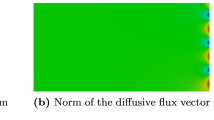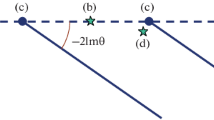Abstract
In this paper, we initiate the study of isogeometric analysis (IGA) of a quantum three-body problem that has been well-known to be difficult to solve. In the IGA setting, we represent the wavefunctions by linear combinations of B-spline basis functions and solve the problem as a matrix eigenvalue problem. The eigenvalue gives the eigenstate energy while the eigenvector gives the coefficients of the B-splines that lead to the eigenstate. The major difficulty of isogeometric or other finite-element-method-based analyses lies in the lack of boundary conditions and a large number of degrees of freedom required for accuracy. For a typical many-body problem with attractive interaction, there are bound and scattering states where bound states have negative eigenvalues. We focus on bound states and start with the analysis for a two-body problem. We demonstrate through various numerical experiments that IGA provides a promising technique to solve the three-body problem.
Access this chapter
Tax calculation will be finalised at checkout
Purchases are for personal use only
Similar content being viewed by others
References
Agmon, S.: Lectures on Exponential Decay of Solutions of Second-Order Elliptic Equations. Princeton University Press, Princeton (2014)
Babuška, I., Osborn, J.: Eigenvalue problems. In: Handbook of Numerical Analysis, vol. II, pp. 641–787. North-Holland, Amsterdam (1991)
Baer, M.: Beyond Born-Oppenheimer: Electronic Nonadiabatic Coupling Terms and Conical Intersections. Wiley, Hoboken (2006)
Boyd, J.P.: Chebyshev and Fourier Spectral Methods. Courier Corporation, Chelmsford (2001)
Breen, P.G., Foley, C.N., Boekholt, T., Zwart, S.P.: Newton versus the machine: solving the chaotic three-body problem using deep neural networks. Mon. Notices Royal Astron. Soc. 494(2), 2465–2470 (2020)
Brezis, H.: Functional Analysis, Sobolev Spaces and Partial Differential Equations. Universitext, Springer, New York (2011). https://doi.org/10.1007/978-0-387-70914-7
Calo, V., Deng, Q., Puzyrev, V.: Dispersion optimized quadratures for isogeometric analysis. J. Comput. Appl. Math. 355, 283–300 (2019)
Cederbaum, L.S.: Born-Oppenheimer approximation and beyond for time-dependent electronic processes. J. Chem. Phys. 128(12), 124101 (2008)
Ciarlet, P.G.: Finite Element Method for Elliptic Problems. Society for Industrial and Applied Mathematics, Philadelphia (2002)
Cottrell, J.A., Reali, A., Bazilevs, Y., Hughes, T.J.R.: Isogeometric analysis of structural vibrations. Comput. Meth. Appl. Mech. Eng. 195(41–43), 5257–5296 (2006)
Cottrell, J.A., Hughes, T.J.R., Bazilevs, Y.: Isogeometric Analysis: Toward Integration of CAD and FEA. Wiley, Hoboken (2009)
De Boor, C.: A Practical Guide to Splines, vol. 27. Springer, New York (1978). https://doi.org/10.1007/978-1-4612-6333-3
Deng, Q., Calo, V.: Dispersion-minimized mass for isogeometric analysis. Comput. Meth. Appl. Mech. Eng. 341, 71–92 (2018)
Deng, Q., Ern, A.: SoftFEM: revisiting the spectral finite element approximation of second-order elliptic operators. Comput. Math. Appl. 101, 119–133 (2021)
Drut, J.E., McKenney, J.R., Daza, W.S., Lin, C.L., Ordóñez, C.R.: Quantum anomaly and thermodynamics of one-dimensional fermions with three-body interactions. Phys. Rev. Lett. 120(24), 243002 (2018)
Efremov, M.A., Plimak, L., Berg, B., Ivanov, M.Y., Schleich, W.P.: Efimov states in atom-molecule collisions. Phys. Rev. A 80(2), 022714 (2009)
Ern, A., Guermond, J.L.: Finite Elements II: Galerkin Approximation, Elliptic and Mixed PDEs. Springer, New York (2020). https://doi.org/10.1007/978-3-030-56923-5
Fonseca, A.C., Redish, E.F., Shanley, P.: Efimov effect in an analytically solvable model. Nucl. Phys. A 320(2), 273–288 (1979)
Griffiths, D.J., Schroeter, D.F.: Introduction to Quantum Mechanics. Cambridge University Press, Cambridge (2018)
Guo, P., Gasparian, V.: Numerical approach for finite volume three-body interaction. Phys. Rev. D 97(1), 014504 (2018)
Happ, L., Zimmermann, M., Betelu, S.I., Schleich, W.P., Efremov, M.A.: Universality in a one-dimensional three-body system. Phys. Rev. A 100(1), 012709 (2019)
Happ, L., Zimmermann, M., Efremov, M.A.: Universality of excited three-body bound states in one dimension. J. Phys. B At. Mol. Opt. Phys. 55(1), 015301 (2022)
Hughes, T.J.R., Cottrell, J.A., Bazilevs, Y.: Isogeometric analysis: CAD, finite elements, NURBS, exact geometry and mesh refinement. Comput. Meth. Appl. Mech. Eng. 194(39), 4135–4195 (2005)
Hughes, T.J.R., Evans, J.A., Reali, A.: Finite element and NURBS approximations of eigenvalue, boundary-value, and initial-value problems. Comput. Meth. Appl. Mech. Eng. 272, 290–320 (2014)
Hughes, T.J.R., Reali, A., Sangalli, G.: Duality and unified analysis of discrete approximations in structural dynamics and wave propagation: comparison of \(p\)-method finite elements with \(k\)-method NURBS. Comput. Meth. Appl. Mech. Eng. 197(49–50), 4104–4124 (2008)
Letellier, C.: Chaos in Nature, vol. 94. World Scientific, Singapore (2019)
Nielsen, E., Fedorov, D.V., Jensen, A.S., Garrido, E.: The three-body problem with short-range interactions. Phys. Rep. 347(5), 373–459 (2001)
Panati, G., Spohn, H., Teufel, S.: The time-dependent Born-Oppenheimer approximation. ESAIM: Math. Model. Numer. Anal. 41(2), 297–314 (2007)
Piegl, L., Tiller, W.: The NURBS Book. Springer, Cham (1997). https://doi.org/10.1007/978-3-642-97385-7
Pisana, S., et al.: Breakdown of the adiabatic Born-Oppenheimer approximation in graphene. Nat. Mater. 6(3), 198–201 (2007)
Puzyrev, V., Deng, Q., Calo, V.M.: Dispersion-optimized quadrature rules for isogeometric analysis: modified inner products, their dispersion properties, and optimally blended schemes. Comput. Meth. Appl. Mech. Eng. 320, 421–443 (2017)
Scherrer, A., Agostini, F., Sebastiani, D., Gross, E., Vuilleumier, R.: On the mass of atoms in molecules: beyond the Born-Oppenheimer approximation. Phys. Rev. X 7(3), 031035 (2017)
Skorniakov, G., Ter-Martirosian, K.: Three body problem for short range forces. I. Scattering of low energy neutrons by deuterons. Soviet Phys. JETP 4 (1957)
Sukhareva, O.M., Grigorenko, L.V., Kostyleva, D.A., Zhukov, M.V.: Validity of quasi-classical approaches to true three-body decays. In: Orr, N.A., Ploszajczak, M., Marqués, F.M., Carbonell, J. (eds.) FB22 2018. SPP, vol. 238, pp. 283–286. Springer, Cham (2020). https://doi.org/10.1007/978-3-030-32357-8_50
Thies, J., Hof, M.T., Zimmermann, M., Efremov, M.: Exploiting tensor structure for computing bound states of the quantum mechanical three-body problem. arXiv preprint arXiv:2111.02534 (2021)
Author information
Authors and Affiliations
Corresponding author
Editor information
Editors and Affiliations
Rights and permissions
Copyright information
© 2022 The Author(s), under exclusive license to Springer Nature Switzerland AG
About this paper
Cite this paper
Deng, Q. (2022). Isogeometric Analysis of Bound States of a Quantum Three-Body Problem in 1D. In: Groen, D., de Mulatier, C., Paszynski, M., Krzhizhanovskaya, V.V., Dongarra, J.J., Sloot, P.M.A. (eds) Computational Science – ICCS 2022. ICCS 2022. Lecture Notes in Computer Science, vol 13351. Springer, Cham. https://doi.org/10.1007/978-3-031-08754-7_42
Download citation
DOI: https://doi.org/10.1007/978-3-031-08754-7_42
Published:
Publisher Name: Springer, Cham
Print ISBN: 978-3-031-08753-0
Online ISBN: 978-3-031-08754-7
eBook Packages: Computer ScienceComputer Science (R0)




